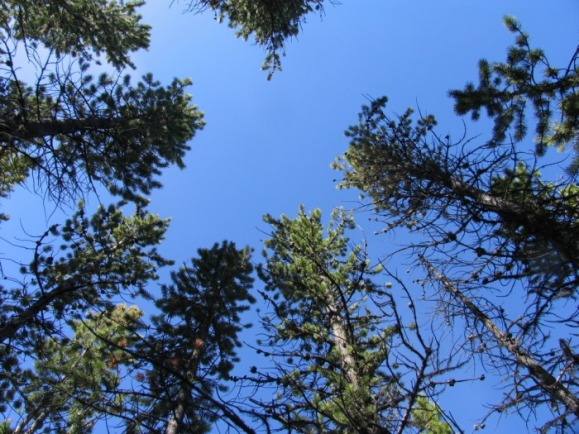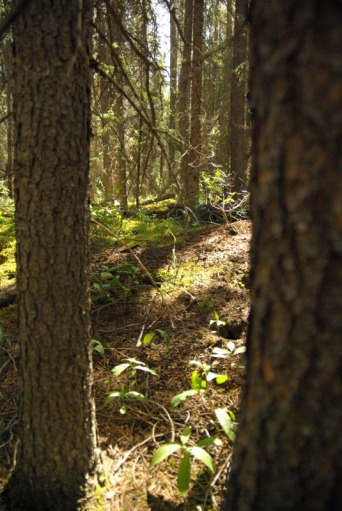Did adaptive growth change tree sway patterns 10 years after thinning?

Tree sway and crown collision frequency plays an important aspect in overstorey canopy dynamics (Rudnicki et al., 2001). In stands with high densities and stem slenderness, impact between tree crowns play a role in tree stability by allowing the transfer of wind energy from one tree to another (Rudnick et al. 2003). This energy transfer from tree to tree allows the momentum created by the wind to pass equally throughout the stand (wind wave). Past research has noted increases in growth of trees left after thinning treatments. The growth is a result of reduced competition for light, nutrients, and growing space (Johnstone and Thienen, 2004; Brockely, 2005).
However, widening of canopy spaces because of tree removal can cause greater wind loading on individual trees as wind tunneling into the canopy increases (Gardiner et al., 2005) and the damping effect of crown to crown contact is reduced (Rudnicki et al. 2003; Rudnicki et al. 2004; Ruel, 1995). This reduction in the damping effect can be seen through changes in tree sway patterns. Thus, as wind forces are placed against a tree, sway patterns often become elongated in axis where a neighboring trees would have previously existed (Rudnicki et al. 2003; Rudnicki et al. 2004). Although frequency of collisions may be reduced through increased crown spaces (fewer trees to collide with), higher sway speeds and sway distances are thought to greatly increase the intensity of collisions occurring (Rudnicki et al. 2003). As more intense collisions occur, reduction in growth can arise as result of direct crown abrasion (twig breakage) and the inhibition of shoots (Meng et al. 2006). Overtime, stands can recover as trees respond to the new wind environment by enhancing stems and root growth (Urban et al. 1994; Ruel, 1995).
However, widening of canopy spaces because of tree removal can cause greater wind loading on individual trees as wind tunneling into the canopy increases (Gardiner et al., 2005) and the damping effect of crown to crown contact is reduced (Rudnicki et al. 2003; Rudnicki et al. 2004; Ruel, 1995). This reduction in the damping effect can be seen through changes in tree sway patterns. Thus, as wind forces are placed against a tree, sway patterns often become elongated in axis where a neighboring trees would have previously existed (Rudnicki et al. 2003; Rudnicki et al. 2004). Although frequency of collisions may be reduced through increased crown spaces (fewer trees to collide with), higher sway speeds and sway distances are thought to greatly increase the intensity of collisions occurring (Rudnicki et al. 2003). As more intense collisions occur, reduction in growth can arise as result of direct crown abrasion (twig breakage) and the inhibition of shoots (Meng et al. 2006). Overtime, stands can recover as trees respond to the new wind environment by enhancing stems and root growth (Urban et al. 1994; Ruel, 1995).

The objective of this study is to research how tree sway patterns have changed, adapted, or adjusted to the long-term responses of a thinning treatment. Crown displacement at selected wind speed of 4, 5, and 6 m/s, will be examined at an individual tree level using the predicting variables DBH, HT, bole slenderness, and crown area. These selected wind speeds correlate to speeds of 14.4, 18.0, and 21.6 km/hr. Crown displacement can be defined as the average distance of movement from resting position at a mid crown level. Further investigation will include destructive sampling of the sensored trees and examination of physiological characteristic that may be attributed to wind response growth (not presented at this time).
At the completion of this study, it is expected that the ten year period since thinning was an adequate length of time for sway patterns of the selected trees to have returned to a pre-thinned pattern. It is also expected that reestablishment of the pre-harvest patterns is a direct result of the trees growth response to the new wind regimes within the stand (thigmomorphogenesis). It is hypothesized that further study into physiological characteristics of growth rings of sensored trees will reveal changes to wood structures (trachides and fibers) in responses to a new wind conditions.
At the completion of this study, it is expected that the ten year period since thinning was an adequate length of time for sway patterns of the selected trees to have returned to a pre-thinned pattern. It is also expected that reestablishment of the pre-harvest patterns is a direct result of the trees growth response to the new wind regimes within the stand (thigmomorphogenesis). It is hypothesized that further study into physiological characteristics of growth rings of sensored trees will reveal changes to wood structures (trachides and fibers) in responses to a new wind conditions.
Disclaimer: this is a class exercise based on modified or randomly generated datasets
